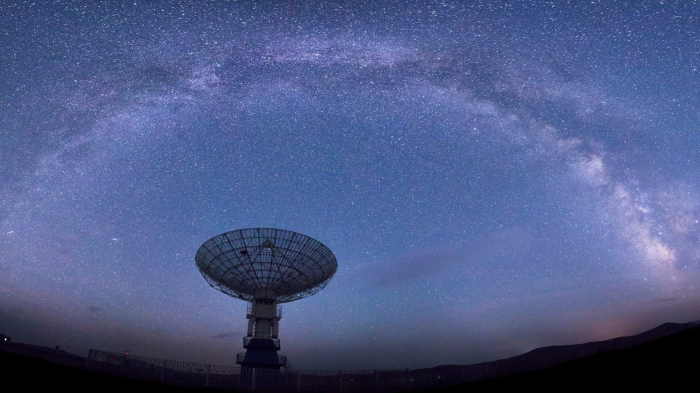The discovery of giant superclusters of galaxies are challenging our very understanding of the Universe.
In 2021, British PhD student Alexia Lopez was analysing the light coming from distant quasars when she made a startling discovery.
She detected a giant, almost symmetrical arc of galaxies 9.3 billion light years away in the constellation of Boötes the Herdsman. Spanning a massive 3.3 billion light years across, the structure is a whopping 1/15th the radius of the observable Universe. If we could see it from Earth, it would be the size of 35 full moons displayed across the sky.
Known as the Giant Arc, the structure throws into question some of the basic assumptions about the Universe. According to the standard model of cosmology – the theory on which our understanding of the Universe is based – matter should be more-or-less evenly distributed across space. When scientists view the Universe on very large scales there should be no noticeable irregularities; everything should look the same in every direction.
Yet the Giant Arc isn't the only example of its kind. These gargantuan structures are now forcing scientists to reassess their theory of how the Universe evolved.
Lopez was studying for her Masters degree at the University of Central Lancashire in the UK when her supervisor suggested using a new method to analyse large scale structures in the Universe. She used quasars – distant galaxies that emit an extraordinary amount of light – to look for signs of ionised magnesium, a sure sign of gas clouds surrounding a galaxy. When light passes through this ionised magnesium, certain frequencies are absorbed, leaving unique light 'signatures' astronomers can detect.
"I looked into known and documented galaxy clusters, and then started plotting what these areas looked like in the Magnesium II method," says Lopez. "One cluster I looked at was very small, but when I plotted it in magnesium II there was this interesting dense band of magnesium absorption across the field of view. This is how I ended up discovering it. It was a happy accident and I was just lucky that it was me that found it."
What Lopez' "happy accident" uncovered was astonishing. When looking towards the constellation Boötes, a cluster of between 45 to 50 gas clouds, each associated with at least one galaxy, seemed to arrange themselves in an arc 3.3 billion light years across. That is a considerable size given the observable Universe is 94 billion light years wide.
According to Lopez's article, it is extremely unlikely (a probability of just 0.0003 per cent) that such a large structure could have arisen by chance. It suggests that it may have formed due to something in the natural physics of the Universe that we currently don't account for. Her findings directly challenge a central facet of the standard cosmological model – the best explanation we have for how the Universe started and evolved.
This facet, known as the cosmological principle, states that on a large scale, the Universe should look roughly the same everywhere, no matter your position or the direction in which you are looking. There should be no giant structures, rather space should be smooth and uniform. This is convenient, as it lets researchers draw conclusions about the whole Universe based only on what we see from our corner of it. However it also makes sense, as following the Big Bang the Universe expanded outwards, flinging matter in every direction simultaneously.
There is another problem. According to the standard model, structures like the Giant Arc simply wouldn't have had time to form.
"The current idea for how structures formed in the Universe is through a process known as gravitational instability," says Subir Sarkar, a professor of theoretical physics at the University of Oxford.
About a million years after the Big Bang, when the Universe was expanding, tiny fluctuations in density led to bits of matter clumping together. Over billions of years, the pull of gravity eventually led these clumps to form stars and galaxies. However, there is a size limit to this process. Anything larger than about 1.2 billion light-years across simply wouldn't have had sufficient time to form.
"To form structures you need particles to congregate close to each other so gravitational collapse can occur," says Sarkar. "Those particles would have to move in from outside the structure to get there. So, if your structure is 500 million light years across, light would take 500 million years to move from one end to the other. However, the particles we are talking about are moving much more slowly than light, so it would take billions of years to create a structure of this size, and the universe has only been around for about 14 billion years."
The Giant Arc discovered by Lopez isn't the only large-scale structure discovered by astronomers.
There's the "Great Wall" (also called the CfA2 Great Wall) of galaxies discovered in 1989 by Margaret Geller and John Huchra. The wall is approximately 500 million light-years long, 300 million light years wide, and 15 million light years thick.
Even bigger is the Sloan Great Wall – a cosmic structure formed by a giant wall of galaxies, discovered in 2003 by J Richard Gott III and Mario Juric and their colleagues at Princeton University. That wall is nearly 1.5 billion light years in length.
In the last decade the discovery of these behemoths has accelerated even further. In 2014, scientists discovered the Laniakea supercluster, a collection of galaxies in which our own Milky Way resides. Lanaikea is 520 million light years across and contains roughly the mass of 100 million billion suns. Then in 2016 the BOSS Great Wall – a complex of galaxies over one billion light years across – was uncovered. BOSS is made up of 830 separate galaxies that gravity has pulled into four superclusters. The galaxies are connected by long filaments of hot gas. In 2020 the South Pole Wall, which stretches 1.4 billion light-years across was also added to the list.
However the current record holder for the biggest of these structures is the Hercules-Corona Borealis Great Wall. Discovered in 2013, it spans 10 billion light years – more than one-10th the size of the visible Universe.
"We calculated it and then realised, 'Uh oh, this is the biggest thing in the Universe'," says Jon Hakkila, professor of physics and astronomy at the University of Alabama in Huntsville.
Their concern was justified. Both Hakkila and Lopez performed a range of statistical tests to try to prove that the results couldn't be down to chance. For the Giant Arc, the results have a confidence level of 99.9997%. In scientific research, the gold standard for statistical significance is known as 5- sigma, which equates to a probability of about 1 in 3.5 million that the results are down to chance. The Giant Arc reached a significance of 4.5 sigma, so there's still the possibility that the structure is a chance arrangement of stars.
"Our eyes are very good at seeing patterns. You might see initials in the clouds, but that's not a real structure, your mind is imposing a structure on what is actually random," explains Sarkar. "However, I don't think that is the case in this situation, I think it is a genuine physical chain of superclusters."
If more structures like the Giant Arc and Hercules-Corona Borealis Great Wall are proven to exist, astronomers will be forced to rewrite – or at least revise – the standard model of cosmology.
It isn't the first time that the model will have had to have been adapted. In 1933, Caltech scientist Fritz Zwicky measured the mass of a cluster of galaxies, and found the number to be smaller than he expected. The mass was so small, in fact, that the galaxies should have flown apart and escaped the gravitational pull of the cluster. Something else, therefore, must hold the clusters of galaxies together.
This "something" is dark matter, a mysterious substance thought to make up 27% of the Universe. Then in 1998, the model was further adapted to include dark energy, after two independent teams of astronomers measured the expansion of the Universe, and found that it was speeding up.
Either way, we should know for sure within the next few years. The Legacy Survey of Space and Time (LSST), a planned 10-year survey of the southern sky, may provide astronomers with an unprecedented view of the Universe.
"It takes a lot to make a paradigm shift, especially when people have their lives and careers invested in it, but ultimately with science we have to see who is right," says Sarkar.
BBC
More about:
















































